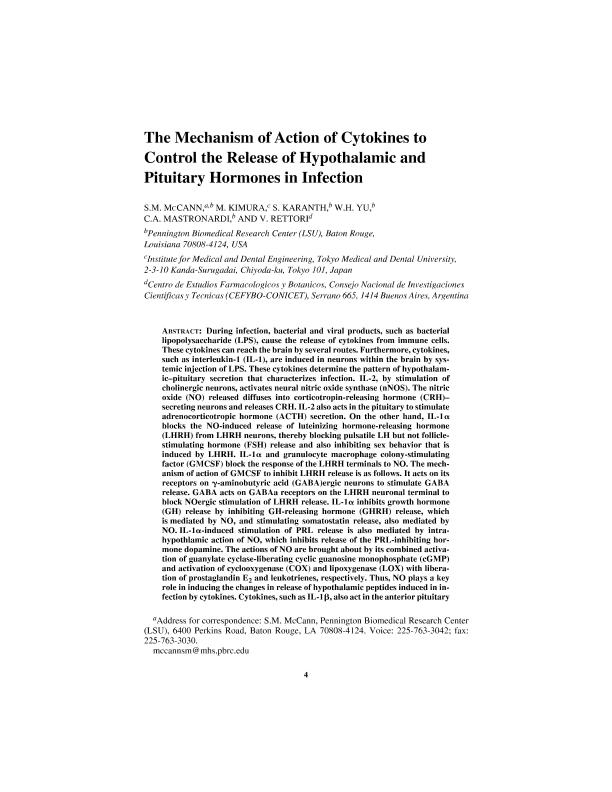Mostrar el registro sencillo del ítem
dc.contributor.author
McCann, Samuel M.

dc.contributor.author
Kimura, M.
dc.contributor.author
Karanth, S.
dc.contributor.author
Yu, W. H.
dc.contributor.author
Mastronardi, C. A.
dc.contributor.author
Besuhli, Valeria

dc.date.available
2018-03-28T14:51:13Z
dc.date.issued
2006-01
dc.identifier.citation
McCann, Samuel M.; Kimura, M.; Karanth, S.; Yu, W. H.; Mastronardi, C. A.; et al.; The Mechanism of Action of Cytokines to Control the Release of Hypothalamic and Pituitary Hormones in Infection; Blackwell Publishing; Annals of the New York Academy of Sciences; 917; 1; 1-2006; 4-18
dc.identifier.issn
0077-8923
dc.identifier.uri
http://hdl.handle.net/11336/40354
dc.description.abstract
Abstract: During infection, bacterial and viral products, such as bacterial lipopolysaccharide (LPS), cause the release of cytokines from immune cells. These cytokines can reach the brain by several routes. Furthermore, cytokines, such as interleukin‐1 (IL‐1), are induced in neurons within the brain by systemic injection of LPS. These cytokines determine the pattern of hypothalamic‐pituitary secretion that characterizes infection. IL‐2, by stimulation of cholinergic neurons, activates neural nitric oxide synthase (nNOS). The nitric oxide (NO) released diffuses into corticotropin‐releasing hormone (CRH)‐secreting neurons and releases CRH. IL‐2 also acts in the pituitary to stimulate adrenocorticotropic hormone (ACTH) secretion. On the other hand, IL‐1α blocks the NO‐induced release of luteinizing hormone‐releasing hormone (LHRH) from LHRH neurons, thereby blocking pulsatile LH but not follicle‐stimulating hormone (FSH) release and also inhibiting sex behavior that is induced by LHRH. IL‐1α and granulocyte macrophage colony‐stimulating factor (GMCSF) block the response of the LHRH terminals to NO. The mechanism of action of GMCSF to inhibit LHRH release is as follows. It acts on its receptors on γ‐aminobutyric acid (GABA)ergic neurons to stimulate GABA release. GABA acts on GABAa receptors on the LHRH neuronal terminal to block NOergic stimulation of LHRH release. IL‐1α inhibits growth hormone (GH) release by inhibiting GH‐releasing hormone (GHRH) release, which is mediated by NO, and stimulating somatostatin release, also mediated by NO. IL‐1α‐induced stimulation of PRL release is also mediated by intra‐hypothlamic action of NO, which inhibits release of the PRL‐inhibiting hormone dopamine. The actions of NO are brought about by its combined activation of guanylate cyclase‐liberating cyclic guanosine monophosphate (cGMP) and activation of cyclooxygenase (COX) and lipoxygenase (LOX) with liberation of prostaglandin E2 and leukotrienes, respectively. Thus, NO plays a key role in inducing the changes in release of hypothalamic peptides induced in infection by cytokines. Cytokines, such as IL‐1β, also act in the anterior pituitary gland, at least in part via induction of inducible NOS. The NO produced inhibits release of ACTH. The adipocyte hormone leptin, a member of the cytokine family, has largely opposite actions to those of the proinflammatory cytokines, stimulating the release of FSHRF and LHRH from the hypothalamus and FSH and LH from the pituitary directly by NO.
dc.format
application/pdf
dc.language.iso
eng
dc.publisher
Blackwell Publishing

dc.rights
info:eu-repo/semantics/openAccess
dc.rights.uri
https://creativecommons.org/licenses/by-nc-sa/2.5/ar/
dc.subject.classification
Otras Ingeniería Médica

dc.subject.classification
Ingeniería Médica

dc.subject.classification
INGENIERÍAS Y TECNOLOGÍAS

dc.title
The Mechanism of Action of Cytokines to Control the Release of Hypothalamic and Pituitary Hormones in Infection
dc.type
info:eu-repo/semantics/article
dc.type
info:ar-repo/semantics/artículo
dc.type
info:eu-repo/semantics/publishedVersion
dc.date.updated
2018-03-16T15:14:18Z
dc.journal.volume
917
dc.journal.number
1
dc.journal.pagination
4-18
dc.journal.pais
Reino Unido

dc.journal.ciudad
Oxford
dc.description.fil
Fil: McCann, Samuel M.. Pennington Biomedical Research Center; Estados Unidos
dc.description.fil
Fil: Kimura, M.. Medical and Dental University; Japón
dc.description.fil
Fil: Karanth, S.. Pennington Biomedical Research Center; Estados Unidos
dc.description.fil
Fil: Yu, W. H.. Pennington Biomedical Research Center; Estados Unidos
dc.description.fil
Fil: Mastronardi, C. A.. Pennington Biomedical Research Center; Estados Unidos
dc.description.fil
Fil: Besuhli, Valeria. Consejo Nacional de Investigaciones Científicas y Técnicas. Oficina de Coordinación Administrativa Houssay. Centro de Estudios Farmacológicos y Botánicos. Universidad de Buenos Aires. Facultad de Medicina. Centro de Estudios Farmacológicos y Botánicos; Argentina
dc.journal.title
Annals of the New York Academy of Sciences

dc.relation.alternativeid
info:eu-repo/semantics/altIdentifier/doi/http://dx.doi.org/10.1111/j.1749-6632.2000.tb05368.x
dc.relation.alternativeid
info:eu-repo/semantics/altIdentifier/url/https://nyaspubs.onlinelibrary.wiley.com/doi/abs/10.1111/j.1749-6632.2000.tb05368.x
Archivos asociados
